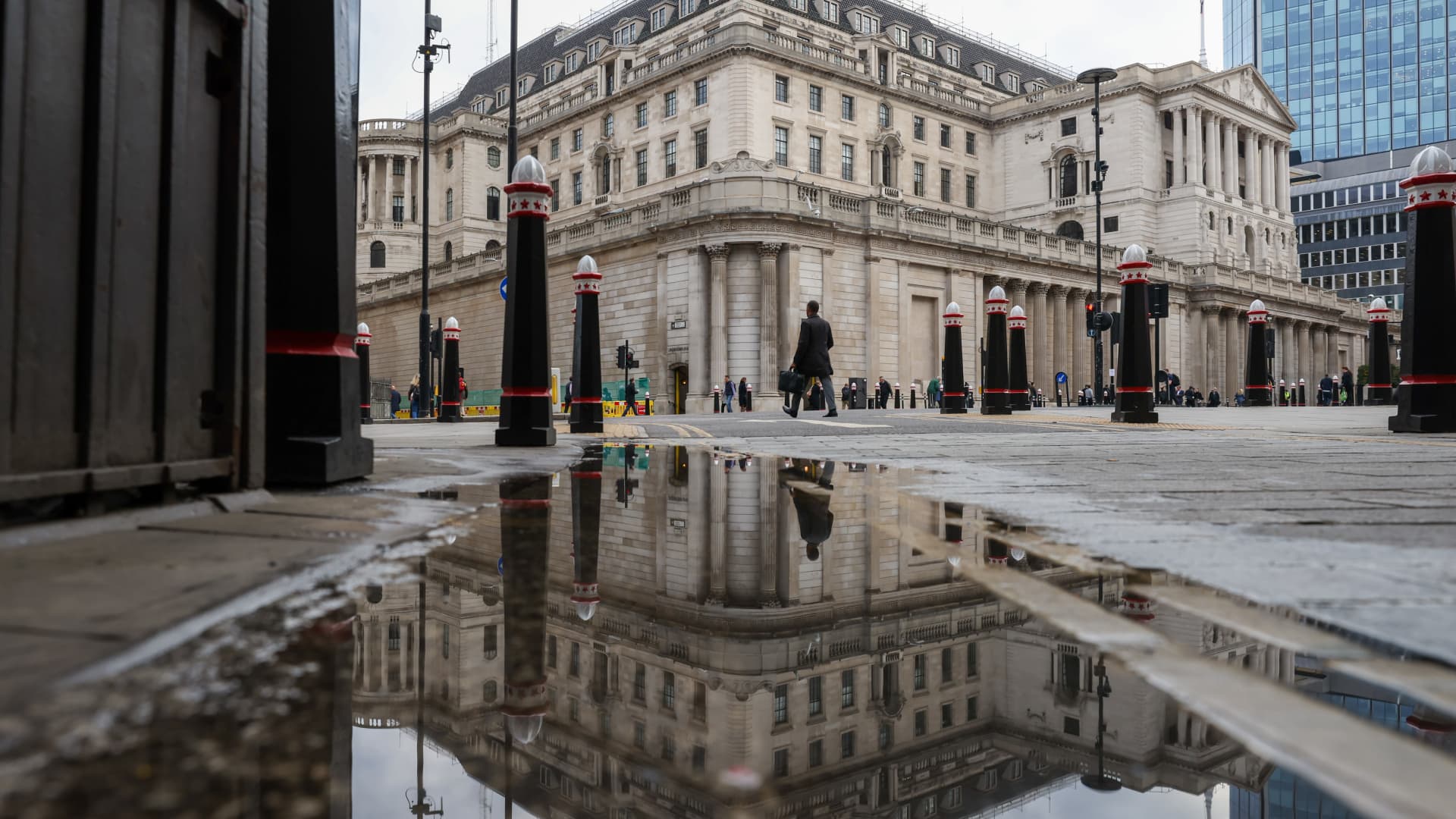UK cliff edge arrives as Bank of England prepares to end its emergency bond buying

The Bank’s Financial Stability Committee on Sep. 28 announced a two-week emergency purchase program for long-dated U.K. government bonds.
Bloomberg | Bloomberg | Getty Images
LONDON — The Bank of England‘s emergency bond-buying program draws to a close on Friday, with traders remaining on edge as volatility in the U.K. bond market looks set to continue.
The central bank initially announced the two-week intervention in the long-dated bond market on Sep. 28, having been informed that a number of liability driven investment (LDI) funds — held by pension plans — were hours from collapse as U.K. government bond prices plunged.
The market volatility was triggered by the British government’s so-called “mini budget” on Sep. 23, which prompted widespread backlash over billions of pounds of unfunded tax cuts while spooking both bond markets and the British pound.
Finance Minister Kwasi Kwarteng will now deliver an updated medium-term fiscal plan on Oct. 31, the same day the Bank of England has earmarked to commence selling gilts as part of its wider monetary tightening efforts.
Kwarteng cut short a visit to the International Monetary Fund in Washington Thursday, flying back to the U.K. as the government convened to address the country’s economic crisis. Reports suggest that a U-turn on the mini-budget’s £43 billion of unfunded tax cuts could be imminent.
The Bank’s Monetary Policy Committee then meets on Nov. 3 to determine its next move on interest rates, and Chief Economist Huw Pill has indicated that the country’s new fiscal framework will necessitate a “significant” monetary policy response as policymakers look to rein in sky-high inflation.
Prime Minister Liz Truss’s government maintains that its sole focus is achieving 2.5% annual GDP growth, but the focus on fiscal support for the economy means Downing Street and Threadneedle Street are pulling in opposite directions, with the Bank of England trying to tighten its belt to cool the economy and contain inflation.
The BOE’s Pill also highlighted that recent actions taken to ensure orderly market function and financial stability sought to preserve the effectiveness of monetary policy, but should not be considered monetary policy actions in themselves.
Bond yields, which move inversely to prices, soared again on Wednesday after Bank of England Governor Andrew Bailey confirmed that emergency support mechanism would be withdrawn on Friday, leaving LDIs with around 72 hours to shore up their balance sheets. The 30-year gilt yield hit 5% for the first time since before the Bank’s historic intervention.
With gilt turbulence expected to persist at least until the government’s fiscal update, some economists expect the market to force more targeted assistance from the Bank in the coming weeks.
“It’s very probable that the Bank of England will resume repurchases because two and two doesn’t equal 22 – it is virtually impossible to wash out the massive amount of negative yielding bonds in the pension funds’ balance sheets without serious pain, so it’s very likely that they will intervene in targeted ways and I would watch out because the next one is the ECB,” said Daniel Lacalle, chief economist at Tressis Gestion.
“What we’re living today in the U.K. is likely to be replicated by Italy, France, Germany even in the next few months.”
Luke Bartholomew, senior economist at Abrdn, noted the level of market uncertainty around the government’s ability to deliver a credible fiscal package at the end of the month, suggesting that volatility may persist and force further interventions from the Bank.
“Clearly the Bank is trying to dispel concerns around fiscal dominance, where it would be forced into more permanent operations to support gilt yields in response to the volatility and re-pricing caused by the government’s fiscal policy,” Bartholomew said in a note Wednesday.
“While the Bank certainly needs to re-assert its independence and the primacy of its price stability mandate, it is far from clear how credible such statements are given the degree of vulnerability exposed in the gilt market.”
Other support measures persist
The temporary purchase program was only one of three components of the Bank’s support package.
Chris Lupoli, U.K. rates and inflation strategist at BNP Paribas, told CNBC Thursday that the Bank of England remained focused on the temporary purchases serving as a “backstop.”
“This is also exemplified by the different valuation approach they are employing at the auctions, when compared to the approach of the historical monetary policy based QE purchases,” he said, pointing to the relatively low values of daily purchases made by the Bank up until Wednesday.
“It is also reflected in the fact that they have only purchased a fraction of the total initial maximum envelope, although this is also a direct function of the low amount of bonds offered at the auctions.”
Lupoli suggested the temporary purchases were an “incremental instrument in the BoE’s financial oversight toolbox,” and may be deployed again in future should any “analogous market dysfunction” occur which the Bank deems a threat to financial stability.
Crucially, the other two additional measures — the Temporary Expanded Collateral Repo Facility (TECRF) and the expansion of the collateral eligibility set for the Indexed Long Term Repo operations — will not terminate on Friday.
Lupoli highlighted that the TECRF, aimed at enabling banks to help ease liquidity pressures on client LDI funds via liquidity insurance operations, had been extended to include non-financial corporate bonds above a certain credit quality.
“Importantly the ability to drawdown cash on this basis (for an initial 30 days, which may be rolled) will run to 10 November 2022; in other words this important cash generating conduit, specifically targeted to the asset side of pension funds will continue beyond this Friday,” he added.









